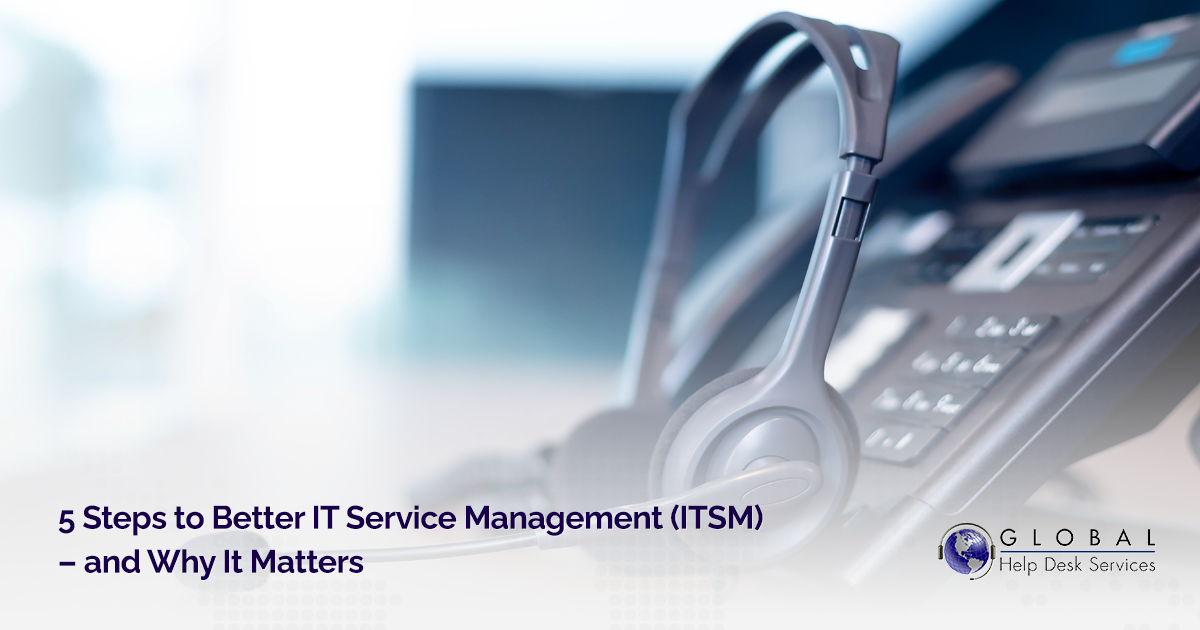Your IT staff aren’t in the hardware business, the software business or the networking business. They’re in the service business.
If you want to improve the way your organization delivers IT services, you must master IT Service Management (ITSM). Without wanting to appear redundant, IT Service Management is how your IT staff manage the delivery of IT services to your customers.
ITSM covers every activity in the delivery of IT services, from strategy to design to development to delivery and support.
Here are five steps you should take to deliver outstanding ITSM.
Step 1: Talk with Your Customers
IT Service Management is all about satisfying the needs of your customers. To deliver great service, you must know your customers. So, start with them. Uncover their needs, challenges, pains, and expectations by asking them the right questions, such as:
- What do you need most?
- How do you typically meet those needs?
- What's important to you?
- What are your IT requirements?
- What are your top IT challenges?
- What can IT do to help you meet your business goals?
Step 2: Create a Benchmark
You cannot know if your IT service delivery is improving (or struggling) until you compare your current performance against a benchmark. This means you must establish benchmarks for the key performance indicators that you want to manage.
Do this first, before you set any goals.
Consider response times, for example. Before you set yourself an ambitious goal of answering every IT request for service within 30 seconds, benchmark where you are right now. How long do you currently take to answer a request? If you currently take around 24 hours, and if you have always taken this long, then this reality should be reflected in your goal for response times.
Not sure what IT help desk KPIs to focus on? A great place to start is with 5 IT Help Desk KPIs That Most Accurately Measure Success.
Step 3: Set Realistic Goals for Service Delivery
Once you have established a benchmark for every metric that matters to you and the customers you serve, create goals around those metrics.
If your response times are too long, for example, set a realistic improvement to those times. Give it a desired number, something you can measure against performance.
For each IT service delivery metric that you aim to improve, start small. In keeping with our example, if your goal is to reduce response times from 24 hours down to one hour, start by setting your IT department the goal of responding to requests within 18 hours. Then, when you have met that goal, further reduce the time to 12 hours. You get the idea.
Ambitious goals look good on a whiteboard but not so great on a performance appraisal report – and they’re a sure way to demoralize your staff. Start small and you’ll learn how to succeed, while building momentum for even bigger goals.
Step 4: Communicate Expectations
Because IT is a service business, it involves a supplier and a customer. Your IT department is the supplier, and your staff, users, departments and others are your customers.
To deliver adequate levels of service, you must meet expectations.
So, the first thing you must do once you have created expectations in the form of measurable performance indicators is to communicate these expectations to your customers.
Setting IT help desk expectations is an exercise in explaining how you’re going to work with each of your customer groups.
This includes your help desk, of course, and anyone who calls the help desk. But it also relates to other support areas within your organization, how you’re going to interact with each one, and the support you deliver for their IT products and services. These groups include your infrastructure teams (how their systems are going to stay up and running), your application support teams (how their apps are going to stay up, and when their release schedule or development cycles are going to happen).
One big advantage of communicating expectations is that it takes the pressure off your IT teams. Users will already have some level of understanding about what's going to happen through the life cycle of their issue – and people tend to be much more patient when their expectations and reality match. Whenever possible, document expectations in service level agreements. This way, both your customers and your IT teams know what to expect.
Step 5: Measure Your Progress
As the name implies, ITSM is all about management. And management means monitoring your progress.
Once you have benchmarked where you are today, and once you have set realistic goals for improving your most important metrics, start reporting on your progress. Pick an interval that works for you, whether daily, weekly, monthly or longer. Then, start generating regular reports that indicate performance, reveal trends and show opportunities for improvement.
Your ticketing software can make it easier – or much, much harder – for your IT help desk to meet its goals. Learn how to pick the right solution: Must Haves (and Pitfalls) When Choosing IT Help Desk Ticketing Software.
A Quick Word About the Why: Benefits of ITSM
If this looks like a lot of work, it is. World-class service takes dedication, training, attention to detail, patience, communication, continuous improvement and team effort.
But the benefits of ITSM make it all worthwhile. Once you deploy and start running a robust IT Service Management program, you can expect to see the following results:
- Improved efficiency: You get more out of your existing resources.
- Lowered operational expenses: You scale your operations more easily without costly hiring.
- Better customer experience: You align IT goals with those of your business, which means you deliver the services your customers need.
- Improved performance: You implement formal processes and rules that standardize IT service delivery.
- Faster resolution: Your improved processes mean your IT teams close support tickets sooner.
- Lower cost per ticket: Your streamlined, measurable processes lower your cost per ticket through improvements in efficiency and agent productivity.
One irony of the IT help desk support space is that lasting success depends not on hardware or software, but on that elusive thing called customer experience. If you want to improve how you deliver IT services, master your IT Service Management. Your customers will thank you for it. And so will your IT staff.
By the way, if the help desk experience you currently provide to your customers generates mixed results, you should consider outsourcing part or all of your IT help desk. Want to learn why? Read our helpful Guide to IT Help Desk Outsourcing.


